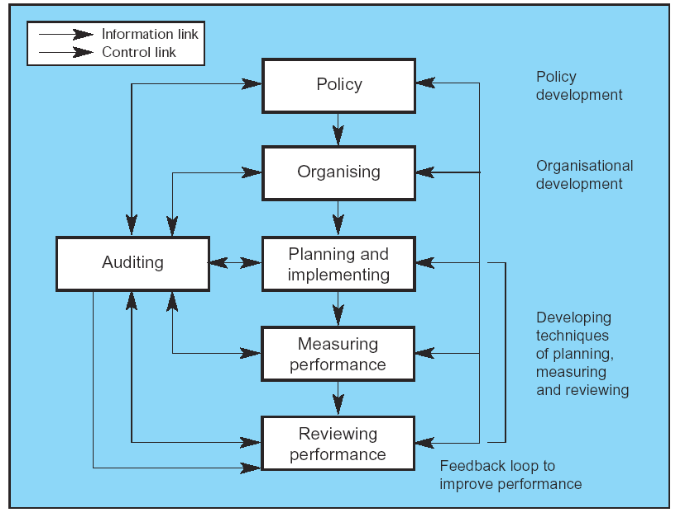II.5- Evolution of the concept of safety culture
Traditionally, attempts to identify the most effective methods
for preventing accidents have typically addressed two fundamental issues:
whether or not employees should be provided with the maximum possible
protection and whether or not employees should be trained to recognize
potentially hazardous situations and take the most appropriate actions.
The first approach is based on the fundamental belief that
protecting an individual from the potential for harm, either by statutory means
or via physical barriers, is the best way to proceed. The second approach is
predicated on the fundamental belief that, if the individual possesses the
relevant knowledge and skills, accidents will be avoided.
The central idea was that the Health and Safety Commission
would promote proactive self-regulatory safety management practices by
influencing attitudes and creating an optimal framework for the organisation of
health and safety. It is clear that legislation can only be effective if it is
adequately resourced and policed. As a result of recent European directive, the
legislative focus has now firmly shifted to proactive management of safety
rather than an inspection of sites/premises approach. Thus employers are now
required to take steps to identify and manage hazards by undertaking formal
assessments of risk say Cooper, (2001 ).
One of the issues highlighted in the literature is the lack of
a universal consensus regarding the terms culture and climate. In many cases
the terms safety culture and safety climate are often used interchangeably. A
good framework based on some work, views safety culture as a product of three
interrelated aspects as stated below, according to Cooper , (2000).
· Psychological Aspects or `safety climate' (individual
and group attitudes, perceptions and values).
· Behavioural Aspects (safety-related actions and
behaviours).
· Situational Aspects (policies, procedures,
organisational structures and management systems).
Organizations with a positive safety culture are characterized
by communications founded on mutual trust, by shared perceptions of the
importance of safety and by confidence in efficacy of preventive measures.
There must be a joint commitment in terms of attitudes and values. The
workforce must believe that safety measures put in place will be effective and
followed even when financial and performance targets may be affected.
With time-tested methodologies in employee, contractor and
process safety, DuPont Sustainable Solutions experts help companies to reduce
lost-time incidents, build skills, and minimize risks, while improving your
efficiency, productivity and safety culture (http://www2.dupont.com).
According to the Royal Aeronautics Society (2004, slide 6) the
best way to measure safety culture is to observe individuals when they are
working. This allows the inspector to witness:
o Hands-on-behaviour - (the `behavioural' aspect of the
culture).
o Management practices and policies.
o The inclusion of human factors considerations in day-to-day
activities.
o Working relationships, communication styles and application
of revised processes.
The approach consists of a self-assessment questionnaire,
designed to help companies identify the strengths and weaknesses within their
HS&E systems, and identify opportunities for improvement. The assessment
covers health, safety and environment, product stewardship; internal
communications and community liaison; and distribution, and provides a
selection of indicators to measure performance and emergency responses
(Chemical Industries Association, 19982b, page 1)
Still continuing with the evolution of safety culture, the
HSE's model for successful health and safety management, namely POPMAR is shown
in Figure 3 below. This encourages organisations to manage health and safety
with the same degree of expertise and to the same standard as other core
business activities, in order to control risks effectively and prevent harm to
people (HSE, 2002b).

Figure 5 -Key Elements of Successful Health and Safety
Management (HSG65)
An explanation of what each stage of POPMAR requires for the
determining of the state of the health and safety management system has been
provided below:
ï Policy -Are there effective policies
in place that set a clear direction for the organisation to follow?
ï Organising -Is there an effective
management structure and are arrangements in place for delivering the policy?
ï Planning and Implementing - Is there a
planned and systematic approach for implementing the policy through an
effective health and safety management system?
ï Measuring Performance - Is performance
measured against agreed standards to reveal when and where improvement is
needed?
ï Auditing and Reviewing - Does the
organisation learn from all relevant experience and apply those lessons?
According to the HSE, the five steps will help to retain staff
within an organisation and help to reduce the cost of injuries, illness, and
property and equipment damage. It is likely that this would also encourage
fewer stoppages, higher output, and better quality. To be a `quality'
organization, sound management principles to health and safety should be
applied (HSE 1998a).
After briefing on the evolution of the issue of safety
culture, we shall look at some indicators which have an influence on it.
| 


